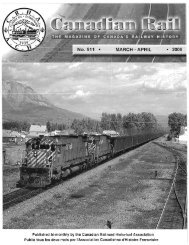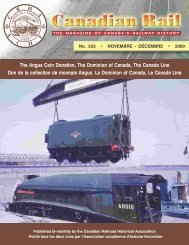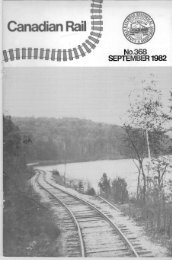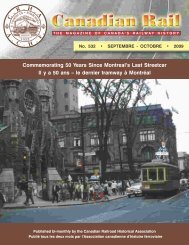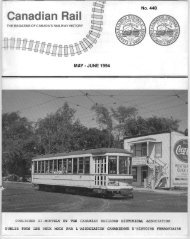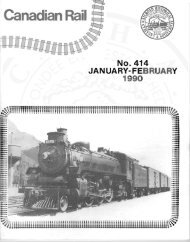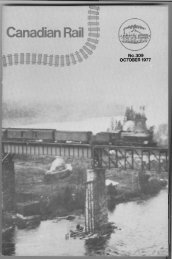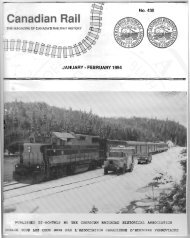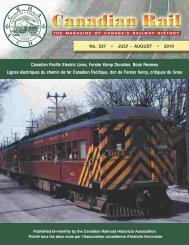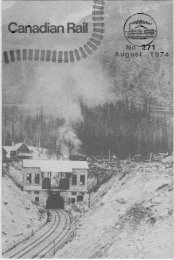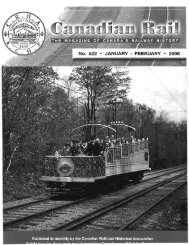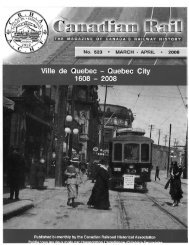Canadian Rail_no538_2010 - Le musée ferroviaire canadien
Canadian Rail_no538_2010 - Le musée ferroviaire canadien
Canadian Rail_no538_2010 - Le musée ferroviaire canadien
You also want an ePaper? Increase the reach of your titles
YUMPU automatically turns print PDFs into web optimized ePapers that Google loves.
RAIL CANADIEN • 538 201<br />
SEPTEMBRE – OCTOBRE <strong>2010</strong><br />
The transition from a rural environment to a<br />
‘bedroom suburb’ took place over many decades. The<br />
greatest exodus from the city to the Lakeshore<br />
communities occurred in the new affluence and<br />
prosperity of the post-Second World War era. This rapid<br />
expansion brought the commuter ridership peaks by the<br />
early 1950’s, but it was also their undoing.<br />
During this period, the automobile came within<br />
the budget of most families, and governments responded<br />
by an unparalleled boom of building streets and highways.<br />
The perceived economics and acknowledged flexibility of<br />
the automobile began to make serious inroads into the<br />
commuter traffic by the late 1950’s. To meet rising costs<br />
and declining revenues, the railways responded by<br />
reducing train frequencies and raising fares.<br />
Locomotives and rolling stock assigned to<br />
Lakeshore commuter service<br />
Grand Trunk - <strong>Canadian</strong> National<br />
The Grand Trunk <strong>Rail</strong>way began building<br />
suburban power for Montreal's Lakeshore commuter<br />
lines as early as 1883 in their Point St. Charles Shops.<br />
Although five of the group were rebuilt to 4-4-0’s in<br />
1888, one survived from this first batch of ten 4-4-2ST<br />
(side tanks) to become CNR X-8-a 41. It was scrapped<br />
in 1923.<br />
CNR X-9-a 42-44 were 4-4-2ST survivors from<br />
a batch of five built at Pointe St. Charles in 1892 for<br />
service on the Toronto Belt Line <strong>Rail</strong>way. All five were<br />
transferred to Montreal in 1894. Two were leased to<br />
the Thousand Islands <strong>Rail</strong>way - the 42 during 1923 and<br />
1924, and 43 between 1924 and 1934. In 1927 the 44<br />
was sold to the Thousand Islands <strong>Rail</strong>way. The<br />
locomotive retained this number until it was retired in<br />
1934 and scrapped in 1937.<br />
Then came the CNR X-10-a class, numbered<br />
45 to 50. They were built by Montreal Locomotive<br />
Works in 1914 and remained in use almost until the end<br />
of CNR's Lakeshore commuter service.<br />
important de la ville vers l’Ouest-de-l’Île correspond à la<br />
période de richesse et de prospérité qui fait suite à la<br />
Seconde Guerre mondiale. Cette rapide expansion se<br />
traduit par une affluence record des trains de banlieue au<br />
début des années 1950. Elle causera également leur<br />
déclin.<br />
La grande popularité de l’automobile pousse le<br />
gouvernement à se lancer dans un programme<br />
d’infrastructure routière sans précédent. L’impact de ce<br />
nouveau moyen de transport souple et économique (du<br />
moins, on le croit) commence à se faire sentir sur le trafic<br />
passagers dès la fin des années 1950. <strong>Le</strong>s compagnies de<br />
chemins de fer répondent à la hausse des coûts et à la<br />
perte de revenus en réduisant le service et en augmentant<br />
les tarifs.<br />
Locomotives et matériel roulant affectés au<br />
service de trains de banlieue de l’Ouest-de-l’Île<br />
<strong>Le</strong> Grand Tronc et le Canadien National<br />
La compagnie de chemin de fer du Grand<br />
Tronc (GT) commence à construire des locomotives à<br />
vapeur dès le début de 1883, dans ses ateliers de Pointe-<br />
Saint-Charles. Bien que cinq d’entre elles soient<br />
reconverties en 4-4-0 en 1888, l’une du premier lot de<br />
10 locomotives 4-4-2ST (avec réservoir latéral) a<br />
survécu sous le nom CNR X-8-a 41. Elle a finalement<br />
été mise au rebut en 1923.<br />
<strong>Le</strong>s locomotives modèle CNR X-9-a, 42 à 44<br />
sont d’anciennes 4-4-2ST récupérées parmi un lot de<br />
cinq construites à Pointe-Saint-Charles en 1892. À<br />
l’origine, elles étaient destinées au Toronto Belt Line<br />
<strong>Rail</strong>way, mais en 1894, elles seront toutes transférées à<br />
Montréal. Deux d’entre elles seront louées au<br />
Thousand Islands <strong>Rail</strong>way : la 42, entre 1923 et 1924, et<br />
la 43, entre 1924 et 1934. En 1927, la 44 sera vendue au<br />
Thousand Islands <strong>Rail</strong>way (sous son numéro d’origine)<br />
jusqu’à ce qu’elle soit mise hors service en 1934, puis<br />
démantelée en 1937.<br />
En 1914, Montreal Locomotive Works (MLV)<br />
construit le modèle CNR X-10-a, numéros 45 à 50. Ces<br />
locomotives resteront en service pratiquement jusqu’à<br />
la fin du service de trains de banlieue du CN dans le<br />
couloir du Lakeshore.<br />
The old and the new - Grand Trunk 4-6-4T 1540 was brand<br />
new when this obviously staged photo was taken in 1914 to<br />
compare the 1540 with the 1532 which had been built in<br />
1892. CRHA Archives, Fonds Corley.<br />
Deux générations se côtoient. La locomotive modèle 4-6-2T<br />
1540 du Grand Tronc sort tout juste des ateliers quand cette<br />
photo est prise en 1914. Elle fait suite au modèle 1532,<br />
construit en 1892. Ces deux locomotives assurent le service<br />
de banlieue du GT dans l’Ouest-de-l’Île. La locomotive 1540<br />
sera rebaptisée CNR 45. Archives de l’ACHF, Fonds Corley.



